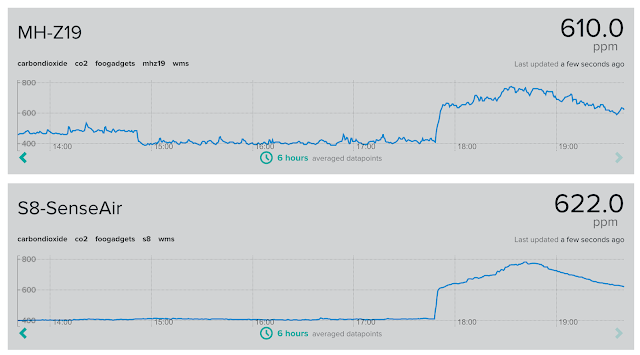The new sensor (MH-Z19) can be found on eBay or Aliexpress from $26 including shipment.
Of course there are differences between the two that is reflected by the price.
I have setup two WMS mk3 side by side. One WMS with an S8 sensor and one with an MH-Z19 sensor. The result is logged to ThingSpeak
The MH-Z19 variant used have a range from 0-5000ppm. As the digital output on the MH-Z19 only can be 0-1000, every digital step represents 5ppm. This probably contributes to the jagginess in the graphs presented below.
First observation when comparing the two graphs is that the MH-Z19 sensor gives a much more jagged curve. Both graphs have the same shape which indicates that the response time is about the same for both. The MH-Z19 has however a slower response time.
The left half of the graphs below should be close to 400ppm as both sensors was placed in the opening of a window. Outside air can be used to calibrate a CO2 sensor since the open air CO2 concentration is constantly very close to 400ppm.
A feature that the MH-Z19 is lacking compared to the S8 is auto calibration (a.k.a. ABC - Automatic Baseline Calibration). The ABC continuously keeps the S8 sensor calibrated.
 | |
|
 |
| Another image that shows the jagged graph from the MH-Z19 sensor. |
Summary
The price/performance ratio for the MH-Z19 is good, and I think it is worth its price and good enough to measure the air quality in an apartment or house. The S8 on the other hand seem to be very much more accurate and there is usually no problem to detect presence of one or several persons in my 97m2 apartment.I will update the blog when the 0-2000ppm MH-Z19 sensor arrives. That variant is likely to give better results as the resolution of the output is 2ppm per step.
Note that the output of the MH-Z19 is always 0-1000 which is shown by the WMS as 0.0°C - 100.0°C
To convert this to a proper carbon dioxide ppm reading, the temperature need to be multiplied by 50.0 for the 0-5000ppm MH-Z19 variant, and by 20.0 for the 0-2000ppm variant.

No comments:
Post a Comment